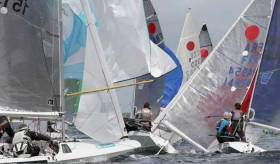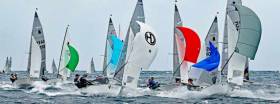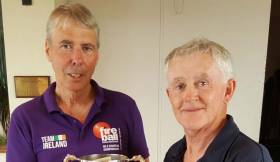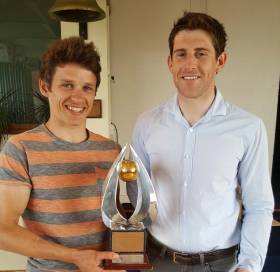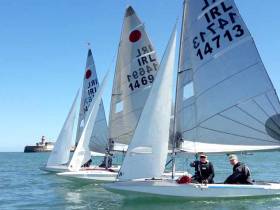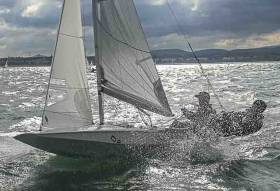Displaying items by tag: Fireball
Black Flag for McCartin & Kinsella at Fireball Worlds
Ian Dobson and Richard Wagstaff still lead the 101 competitors with 7 points after 4 races by the end of say 2 of the 2018 Fireball Worlds in Carnac, France.
Lying second are Penny and Russell Clarke just 2 points behind while Matt Burge and Daniel Schiber are still third with 12 points. Conditions today Monday featured pleasant medium winds allowing trapezing up the beat with wind about 8-10 knots average.
The wind clocked slightly right for race one and more or less stayed there though there was slightly better breeze for race 2. Barry McCartin and Conor Kinsella were black flagged in the first race of the day and had a 24th in the race 4 of the series pushing them back from 8th to 24th overall.
Niall McGrotty and Neil Cramer suffered a broken trapeze ring (as did Tim Saunders) but sailed solidly and are now 52md overall.
Louise McKenna and Hermine O'Keeffe had an excellent first race getting off the line cleanly and scoring a 42nd bumping them up to 55th overall. Frank Miller and Ed Butler had a poor start in race one and are now 75th overall.
Tuesday's forecast looks tricky with light shifty winds.
Royal St. George's McCartin & Kinsella in Top Ten at Fireball Worlds
The 101 boats at the Fireball Worlds in France had an exciting day on the water with wind strength of the order of 16 – 22 knots and good waves to negotiate upwind and enjoy downwind writes Cormac Bradley.
A “three-committee boat” arrangement was put in place for the starts with the middle boat making the starting signals. The first start had a slight starboard bias and with the wind clocking right, a huge bunch assembled at the right hand side leading to U-starts and black flags. Five attempts at starting were made before the fleet got away. Facebook reports suggest that the recipe was repeated in the second start, except in this instance the favoured end was the pin.
Course symmetry was reported as being exemplary, giving very exciting reaches but still allowing spinnakers to be flown.
The attrition rate in the second race was more pronounced with a wooden French boat having to be towed ashore when its tanks filled and a number of retirees after “fun and games” at the gybe mark.
2018 Fireball Worlds, Carnac, NW France
Day 1; Sunday 26th August 2018.
Helm & Crew Sail No. R1 R2 Tot.
1 Ian Dobson & Richard Wagstaff GBR 15141 2 2 4
2 Penny & Russell Clark GBR 15096 4 1 5
3 Matt Burge & Dan Schieber GBR 15123 3 3 6
4 David Wade & Richard Pepperdine GBR 14143 6 4 10
5 David Hall & Paul Constable GBR 15122 7 5 12
6 Tom Gillard & Geoff Edwards GBR15127 1 14 15
7 Barry McCartin & Conor Kinsella IRL 15114 10 6 16
8 Paul Cullen & Simon Forbes GBR 15147 9 7 16
9 Milan Cap & Filip Prochazka CZE 15131 11 8 19
10 Peter & Tom Kyne GBR 15124 13 9 22
The leading French combination, their 2018 National Champions, Ludovic Alleaume & Loic Bertholet, are in 13th place with a 16th and a 15th. The solitary Aussie entry, Heather Macfarlane & Chris Payne are in 18th, counting a 22 and a 18. A number of high profile combinations find themselves in the latter pages of the results by way of carrying a Black Flag score in the second race.
Of the balance of the Irish, the best are Niall McGrotty & Neil Cramer in 42nd (54,39), followed by Louise McKenna & Hermine O’Keeffe in 59th (69,52), while Frank Miller & Ed Butler had a more trying day counting a 61 and a DNF when their spinnaker got wrapped around the spreaders after a gybe/capsize!
Irish Sailors Depart for French-Hosted Fireball Worlds
An Irish team of four boats departs these shores today for the French Fireball Nationals and Fireball Worlds in Carnac, north-west France writes Cormac Bradley. The combined regatta, with the French Nationals acting as a warm-up for those who want to familiarise themselves with the venue, begins on the 22nd of August (Wednesday) and runs through to the Friday of the following week, the 31st.
Three of the Irish entries will sail the French Nationals which boats a 68-boat entry with eight countries represented – Australia, Belgium, Canada, the Czech Republic, Great Britain, Kenya, South Africa and Switzerland. Names to watch out for in this fleet will be current World Champion Helm, Tom Gillard, sailing with Geoff Edwards (GBR 15127), current UK National Champions, Ian Dobson & Richard Wagstaff (GBR 15141), the Australian couple Heather Macfarlane & Chris Payne (AUS 15152) who finished 2nd in the recent UK Nationals, the Swiss combination, Claude Mermod & Reudi Moser (SUI 14799), the 2016 European Champions, David Hall & Paul Constable (GBR 15122) and the Czech combination Pavel Winkler & Jaroslav Verner (CZE 15110). If conditions suit them, Derian and Andy Scott (GBR 14941) will also be in the frame. After taking a break from sailing Fireballs, due to a knee operation and other bigger boat distractions, Barry McCartin & Conor Kinsella (IRL 15114) got back into Fireballs in 2018 to sail the regatta circuit and will have ambitions to do well in France.
As recently as Saturday past, they were out sailing in Dublin Bay as a preamble to the French Nationals.
After the shake-down of a French Nationals, the focus will turn to the Worlds which have attracted an entry of 101 boats and another country entry in the form of a solitary Italian boat. The Worlds has also attracted a much bigger GBR contingent of boats with the likes of Immediate Past Commodore Steve Chesney, sailing with Angus Cummings (GBR 15150) and another former FI Commodore, Russell Thorne, teaming up with Kevin Hope (GBR 15133) joining the fray.
Current Commodore Christina Haerdi-Landerer will sail with Cedric Landerer (SUI 14859) in the Worlds, while another former Commodore, Joe Jospe of Canada will make his near-annual trek across the Atlantic with regular crew, Tom Egli (CAN 15024), but they will sail both events. Rear Commodore Africa, David Laing of South Africa, will also sail both events with Mark Dee (RSA 14877).
While this scribe is not “au-fait” with the strength of the French Fireball fleet, the fact that this regatta is in home water must surely guarantee that French combinations will be vying for top ten places.
Of the remaining Irish entries, Louise McKenna & Hermine O’Keeffe (14691), Frank Miller & Ed Butler (14713) and Niall McGrotty & Neil Cramer (14938), none are “first-timers” to international Fireball regattas so they will be looking to get into the upper echelons of both fleets.
The Irish contingent will also be starting the “awareness campaign” for the 2020 Fireball Worlds which will be hosted by Howth Yacht Club and members of Howth’s organising committee will also be in Carnac to observe proceedings. While it won’t be a hard-sell just yet, in respect of the preceding Worlds in Montreal next year, there is a requirement for the host country in two years’ time to do a soft sell at the Worlds. Of the eight Irish Fireballers sailing in France, four are on the national committee; Neil Cramer (Chairman), Frank Miller (Secretary), Hermine O’Keeffe (Dun Laoghaire Class Captain) and Louise McKenna (Committee Member).
Resilient Irish Sailing Scene Moves on From This Week’s Setbacks
With 178 Optimists racing in the Irish Nationals at Kinsale, and Ireland’s GP14 dinghies in fine form after the massive Worlds in England as they gather for their own Nationals in Sligo this weekend through to Monday, there’s much to be hopeful about even as our cruiser-racers deal with the fallout from the multi-gale depredations on the programme in the ICRA Nationals at Galway, and the damage-forced retirement from the Round Britain & Ireland Race of Conor Fogerty and Simon Knowles in Bam! W M Nixon hopes to brighten the mood.
The remains of Subtropical Storm Ernesto could not have chosen a more inconvenient time to swing by the west coast of Ireland and the Outer Hebrides of Scotland than during this past week.
For meteorologists, one of the curiosities was that Ernesto was so all-encompassing that he included in his swirling airmass not only an enormous long plume of smoke from the wildfires in California, but dust from the Sahara. That’s globalisation, and no mistake.
Subtropical Storm Ernesto
And he also brought us in Ireland far more than our fair share of extremely humid and unstable air, lots of it moving at near gale force, with all of it very dense to exacerbate the effects of wind speed. With its added ingredients of smoke and dust, it was not only humid – it was arguably putrid.
 Somewhere, the sun is shining……this was the Optimist Junior Fleet in action off Kinsale on Thursday. Photo: Robert Bateman
Somewhere, the sun is shining……this was the Optimist Junior Fleet in action off Kinsale on Thursday. Photo: Robert Bateman
Seen from a lee shore, the Ernesto Effect produced unspeakable sea and sailing conditions which made race cancellations in Galway Bay inevitable. And for those already out at sea and racing in the RB & I marathon, the endlessly varying wind strengths and its many weaving directions led to widespread damage in the Sevenstar fleet, and several retirals to ports along Ireland’s Atlantic seaboard.
Up to a point, we could take it all in our stride. But when Bam!’s dejected crew were forced to pull out on Thursday morning, it was time and more to look elsewhere for signs of encouragement in the Irish sailing scene, news and stories to remind us that, until a week ago, the season of 2018 was going very well indeed, and it will soon be back on track again.
178 Optimists at the Nationals in Kinsale
So that figure of 178 Optimists at the Nationals in Kinsale is hugely encouraging, particularly when we remember that the Irish Optimist racing scene is so highly regarded internationally that teams from six other nations have come to Kinsale to race as Open division entries.
Because it’s children’s sport, some limits apply in reporting Optimist success. But when new stars such as Justin Lucas of Clonakilty and more recently Rocco Wright of Howth emerge with brilliant performances, the news gets out.
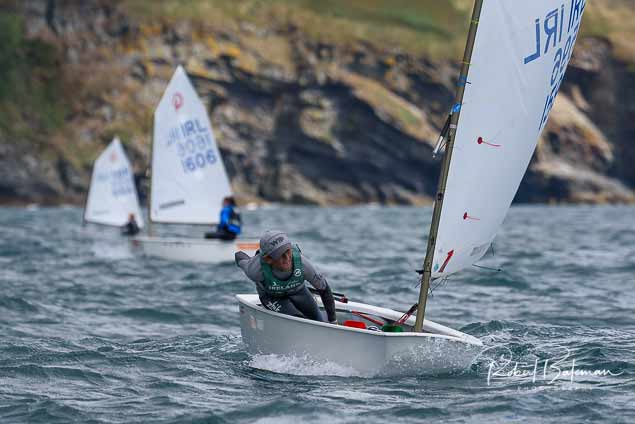 Rising star. Justin Lucas of Royal Cork & Tralee is one of Irish sailing’s most successful youth helms
Rising star. Justin Lucas of Royal Cork & Tralee is one of Irish sailing’s most successful youth helms
And living as I do in an Optimist neighbourhood (half the houses in our road seem to have evidence of at least one Optimist dinghy in the family), part of the fascination of Optimist campaigning is its entertainment value for the rest of us. When you see an entire family (including the pooch) heading off for a championship with the total package of support RIB, several Optimists attached here, there and everywhere - with the roof-rack of the SUV also utilized – then you’re really looking at something special, yet we take it for granted.
It’s very much a combined effort, and that is something which we see manifested in other successful classes such as the close-knit Flying Fifteens in Dun Laoghaire, and the GP 14s nationwide.
GP14 Worlds 2020 at Skerries
In an era when novelty and innovation seem to be the priorities that we seek in vehicles and equipment, the GP 14 is a real curiosity. She goes all the way back to 1949 – yes, she’ll be 70 next year – and her original purpose was that, as a hard-chined boat built in marine plywood, she could be home-built by any reasonably competent Do-It-Yourself enthusiast at a time when DIY was widely popular.
She was called the GP as it meant General Purpose and most assuredly not Grand Prix, with day cruising or even longer non-racing ventures considered an option. But soon, the new boat had acquired a spinnaker, and racing was on the agenda and moving rapidly towards the top. It has stayed there ever since as the GP 14’s main purpose in life.
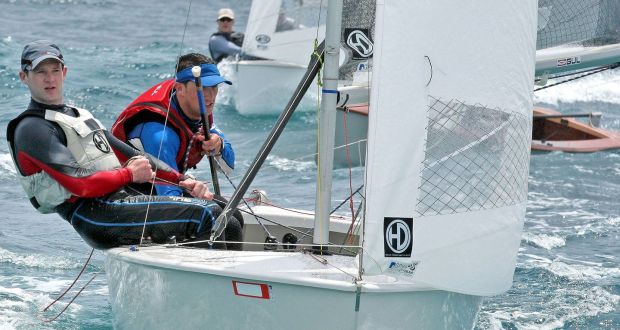 Andy Davis (left) and Greystone SC’s Shane MacCarthy on their way to winning the GP 14 Worlds 2016
Andy Davis (left) and Greystone SC’s Shane MacCarthy on their way to winning the GP 14 Worlds 2016
Many new dinghy designs have appeared since 1949 to promote fresh classes, yet the GP 14 continues to trundle successfully along – more than 14,000 have been built worldwide. And though glassfibre construction has been used in some cases – Shane MacCarthy of Greystones won the GP 14 Worlds in 2016 in Barbados in a GRP GP14 – wood construction continues to be much favoured, and one of the very best builders in the world is Alistair Duffin of East Belfast, who succeeded his father Gerry in the business of creating exquisite wooden boats which are also race-winners.
 The unmistakable look of a Duffin GP14 hull – this one won the Worlds in 2012
The unmistakable look of a Duffin GP14 hull – this one won the Worlds in 2012
His boat-building skills are such that other classes try to avail of his services when there’s the tiniest gap in his GP 14 orderbook – at the moment he’s putting a new deck on a Dublin Bay Mermaid, evidence of another of Ireland’s much-loved older classes finding itself with a new lease of life.
One aspect of such classes is that they give you the feeling of being in one great big family, and certainly in the GP14s in particular, the family thread runs strong, with parents as readily crewing for children as the other way round.
The class is renowned for its provision of good value for its members. This was particularly apparent when the GP 14 Worlds of 2014 was held at East Down Yacht Club on Strangford Lough. The renowned Norman Lee of Greystones was among those taking part with his impressive compact largely self-created equipage of campervan-cum-workshop with boat and gear and spares, all of it on site and typical of a class where a monumental yet quietly effective community effort was needed each day to get the fleet – almost exactly a hundred in all – neatly away for each day’s racing.
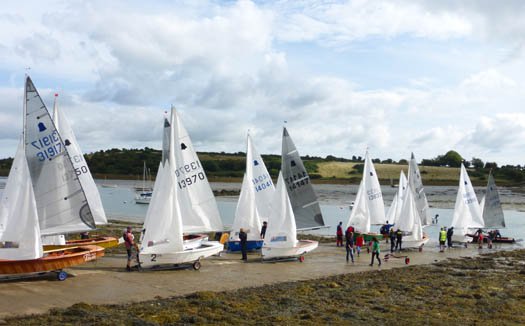 Fleets at most of the biennial GP 14 Worlds are so large that a convenient beach can be very useful, but in 2014 at East Down YC on Strangford Lough, they had to rely on a well-organised routine down a long slipway. Photo: W M Nixon
Fleets at most of the biennial GP 14 Worlds are so large that a convenient beach can be very useful, but in 2014 at East Down YC on Strangford Lough, they had to rely on a well-organised routine down a long slipway. Photo: W M Nixon
This sense of readily-supported group effort within GP 14 Ireland reached a new level in 2016, when the Worlds were set for Barbados in March. The prospect of Caribbean sailing at the tail end of the Irish winter was a mighty attraction, but the logistics of it would have been beyond most classes. Yet the unrivalled community spirit within the Irish GPs saw 22 boats being taken Transatlantic in a well co-ordinated container movement combined with an affordable travel and accommodation package which was negotiated though sensible group action, and planning well ahead.
The fact that in some magnificent racing the new GP 14 World Champion was to emerge as Shane MacCarthy of Greystones, crewed by Andy Davis, was the perfect finishing touch to a great adventure, and a timely reminder that the Irish GP 14 class has had its World Champions in the past, with Bill Whisker and Jimmy McKee of Ballyholme winning in 1975, while Mark and Paul Fekkes from Larne won in 1991.
Thus the main international focus for the Irish class this season has been the recent GP 14 Worlds in southwest England at Mounts Bay in Cornwall, where a convenient gently sloping beach provides the exceptional launching facilities required by a fleet of 117 boats, for which 17 travelled from various Irish centres, while total Irish participation was pushed above the 20 mark with our GP 14 sailors who currently live in Britain.
 The distinctive shape of St Michael’s Mount dominates the race area during the recent GP14 Worlds at Mounts Bay in Cornwall. Irish helms took second and fourth in the 117-strong fleet.
The distinctive shape of St Michael’s Mount dominates the race area during the recent GP14 Worlds at Mounts Bay in Cornwall. Irish helms took second and fourth in the 117-strong fleet.
Inevitably, defending champion Shane MacCarthy was something of a marked man, and going into the final race he seemed assured of the bronze. But he was pushed into fourth, and the best of the Irish was Ross Kearney with the Silver, sailing under the burgee of the Royal North of Ireland YC at Cultra, and crewed by Ed Bradburn of South Staffs SC.
After Shane MacCarthy in fourth, next best of the Irish was Ger Owens of Royal St George YC at 9th. He is one of those leading Irish dinghy sailors who is equally renowned for his successes in other boats, most of them of more modern type, yet he reckons that for sport and value, keeping a GP 14 in trim and having someone as able as regular crew Melanie Morris to campaign with makes it well worth the effort.
In a fleet of this size, everyone will have found their level where the sport is at its best, and age is no barrier. We wouldn’t dream of even guessing at the age of Curly Morris of Larne, but he has been sailing GP 14s for as long as we’ve known him, which is very far back into the previous millennium. Yet there he was at Mounts Bay, merrily sailing around with all his replacement joints in reasonable working order, and taking 19th overall with Laura McFarland of Newtownards SC as his crew.
 Supersenior Sailor – veteran Curly Morris is as keen as ever. Photo: Robert Bateman
Supersenior Sailor – veteran Curly Morris is as keen as ever. Photo: Robert Bateman
As for top all-women crew, that went to Katy Dwyer and Michelle Rowley of Sutton Dinghy Club, who were comfortably into the top half at 41st, which gave them a solid fifth in the Silver Fleet.
With full-on across-the-board participation by the Irish entries as events concluded at Mounts Bay in the first week of August, there’s been little enough time to re-charge batteries before this weekend’s Sligo gathering. But with GP 14 Ireland in the build-up to another big one on the home front within two years, the momentum is on, with the count-down already under way towards the GP 14 Worlds 2020 at Skerries, where this year in July they’ve already staged the Leinsters, won by Shane MacCarthy with Ger Owens second and Alan Blay and David Johnston of Sutton third.
This will put a double-focus on MacCarthy at Sligo, as he’s defending National Champion, having won at Ballyholme last year. So all that’s needed in Sligo is a relenting of the weather to set the stage for the sort of racing the GP 14s relish.
It speaks volumes of a class in good heart, and with GP14 Ireland now having David Cooke of Skerries as President, there’s a strong home team in place to provide a World Championship worthy of the competitors, while on the boat front, the word is that Alistair Duffin’s order book for new GP 14s is well-filled to 2020.
World Sailing Championships on the Fingal Coast
It all means that 2020 is going to be quite a year for World Championships on the Fingal coast, as fourteen miles to the south at Howth, one of HYC’s main events for 2020 will be staging the Fireball Worlds.
 The National YC’s John Lavery on the helm and David O’Brien on the wire, on their way to winning the Fireball Worlds 1995 in Dublin Bay. The Fireball Worlds 2020 will be staged at Howth. Photo: Shane O’Neill
The National YC’s John Lavery on the helm and David O’Brien on the wire, on their way to winning the Fireball Worlds 1995 in Dublin Bay. The Fireball Worlds 2020 will be staged at Howth. Photo: Shane O’Neill
While the Fireball Class doesn’t have the same national coverage in Ireland as the GP 14, it continues to be a significant international force, and of course Irish faith in the Fireball is still sustained by memories of the World Championship in Dublin Bay in 1995, won by John Lavery and David O’Brien of the National Yacht Club.
The very idea that the coast of Fingal would be hosting two world championships at two different venues within the county in 2020 would have been seen as far-fetched back in 1995. But population growth has seen club development across the board in the north county – think, for instance, of the remarkable growth of Rush Sailing Club’s success – and the area’s lack of commercial shipping is a real boon when Dublin Port’s increasing activity keeps the Bay’s shipping lanes busier than ever.
Then, too, when the Atlantic weather is excessively flexing its muscles, the well-islanded coast of Fingal’s great sailing water has all of Ireland to provide a lee when the big westerlies roar across country to make racing events impossible on open water on the Atlantic seaboard.
Half Ton Classics Worlds at Nieuwpoort
So between Optimists and GP 14s and Fireballs, there is much to cheer us in the current and future scene. And as for cruiser racing, there may have been a glitch, but in the Irish Sea ISORA soldiers on, and we’ve two Howth boats – Dave Cullen’s Checkmate XV and Jonny Swann’s Harmony – in with a shout in next week’s Half Ton Classics Worlds at Nieuwpoort in Belgium. Life goes on.
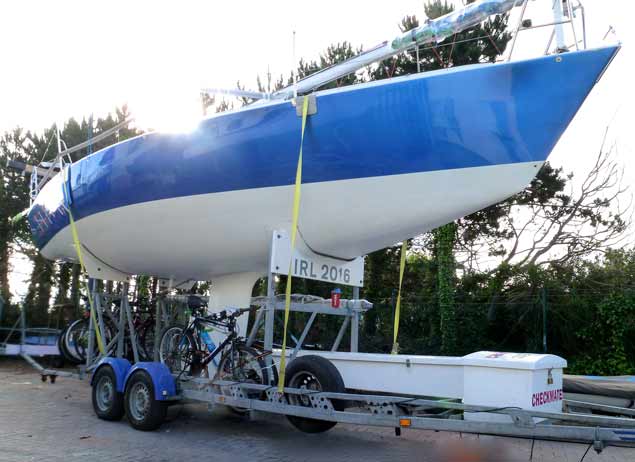 All packed up, and ready to go….Dave Cullen’s classic Half Tonner Checkmate XV road-ready at Howth for departure to Nieuwpport in Belgium and the Half Ton Classic Worlds which start on Monday. Photo: W M Nixon
All packed up, and ready to go….Dave Cullen’s classic Half Tonner Checkmate XV road-ready at Howth for departure to Nieuwpport in Belgium and the Half Ton Classic Worlds which start on Monday. Photo: W M Nixon
 No, you weren’t seeing things – Checkmate XV travels with five crew bicycles, as getting around some yacht harbours takes longer than you think, and the exercise is good for them. Photo: W M Nixon
No, you weren’t seeing things – Checkmate XV travels with five crew bicycles, as getting around some yacht harbours takes longer than you think, and the exercise is good for them. Photo: W M Nixon
 Jonny Swann’s Harmony, overall winner of the all-comers Harbour Race in Volvo Cork Week, will also be representing Howth in the Half Ton Championship in Belgium. Photo: Robert Bateman
Jonny Swann’s Harmony, overall winner of the all-comers Harbour Race in Volvo Cork Week, will also be representing Howth in the Half Ton Championship in Belgium. Photo: Robert Bateman
Fireballs Get Sunshine & Sea Breeze in Greystones
The Irish Fireball fleet raced their Open Championships by joining Greystones Sailing Club for their 50th Dinghy Regatta with a schedule of four races for the Saturday. The Irish East Coast has been enjoying glorious sunshine over the past couple of weeks but that hasn’t always translated into great sailing/racing weather. Dun Laoghaire was like the Mediterranean on Friday – gloriously hot, but with very little wind!
Greystones on Saturday morning offered the same sunshine conditions but along with it was what looked like a decent sea-breeze. The breeze lasted all day but wasn’t as strong as it looked from the shore, offering only some off-wind trapezing in the early stages of the day, before it came on a little stronger for the 4th race, allowing some limited upwind trapezing.
Race wins were shared on a ratio of 3:1 between Niall McGrotty & Neil Cramer (14938) from Skerries Sailing Club and Frank Miller & Cormac Bradley (14713) from Dun Laoghaire Motor Yacht Club, with Bradley making his summer racing debut in the Fireball. In terms of 2nd places, Miller & Bradley took the “win” by three races to McGrotty & Cramer’s one. Neil Colin & Margaret Casey (14775), also from Dun Laoghaire Motor Yacht Club and also making their summer debut in Fireballs took third place by having three 3rd places in the first three races.
Greystones were their normal hospitable selves and gave the Fireballs a start with the Fast PY Fleet, consisting of the RSs – 400s and 200s, but set the two classes separate courses – the Fireballs sailing triangle-sausage-triangle while the RSs sailed two laps of a windward-leeward course. This dispensation still managed to generate some interaction between the Fireballs and the leading RSs at both the windward mark and the leeward mark and on more than one occasion, the Fireballs tried to put an RS between themselves and their class opposition.
The Slow PY Fleet was a combination of GP14s, Wayfarers, Lasers, Fevas and Hartley 12s, with one prominent Wayfarer personality sailing single-handed.
Despite the small turnout, Greystones gave prizes to the 1-2-3 in the Fireball class – engraved crystal prizes with the Greystones club logo incorporating a “50th”.
|
Irish Fireball Open Championships; Greystones Sailing Club |
R1 |
R2 |
R3 |
R4 |
Tot |
|||
|
1 |
Niall McGrotty & Neil Cramer |
14938 |
Skerries Sailing Club |
1 |
1 |
1 |
2 |
3 |
|
2 |
Frank Miller & Cormac Bradley |
14713 |
Dun Laoghaire Motor Yacht Club |
2 |
2 |
2 |
1 |
5 |
|
3 |
Neil Colin & Margaret Casey |
14775 |
Dun Laoghaire Motor Yacht Club |
3 |
3 |
3 |
5 |
9 |
The 2020 Fireball World Championships have been awarded to Howth Yacht Club in Dublin.
As David O'Brien in the Irish Times Sailing Column reveals here, the top-flight dinghy event will bring competitors from as far as Africa and Australia to North Dublin waters in two years time.
The club, established in 1895, is one of the largest yacht clubs in both Ireland and the UK offering exceptional facilities for dinghy and keelboat sailors. Howth Yacht Club has the depth of experience required to provide consistently high standards of race management at club, national and international level. The club has a resident national and international race management team along with dedicated committee boats and a professionally maintained racing infrastructure. The race area is exceptional with a large expanse of open water, free from tidal anomalies and with flat water from the prevailing westerly winds crossing a low flat plain to the west. For the Fireball Worlds a highly experienced regatta team has been assembled led by event chairperson Judith Malcolm and Principal Race Officer David Lovegrove, one of Ireland’s most experienced International Race Officers and a former Fireball sailor himself.
"A highly experienced regatta team has been assembled"
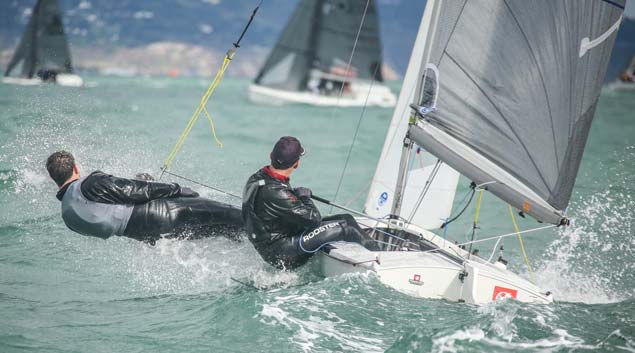 Irish Fireball champions Barry McCartin and Conor Kinsella from the Royal St. George Yacht club are leading contenders for the 2020 title on home waters Photo: Afloat.ie
Irish Fireball champions Barry McCartin and Conor Kinsella from the Royal St. George Yacht club are leading contenders for the 2020 title on home waters Photo: Afloat.ie
The venue is located on a peninsula some 18km from Dublin city centre in a high amenity area of exceptional natural beauty and is the second most popular tourist location in the Dublin area. The clubhouse is only 20mins drive from Dublin’s international airport, adjacent to the coastal DART suburban train line to Dublin City and 30 mins from the ferry terminals at Dublin Port. The main event takes place from 9th-14th August 2020 with a short warm-up event expected in advance.
 Dublin's Howth Yacht Club is the venue for the 2020 Fireball World Championships
Dublin's Howth Yacht Club is the venue for the 2020 Fireball World Championships
Howth Yacht Club has previously hosted the Etchells, J24, Optimist and Mirror world championships, many national and regional Laser Regattas and IRC championships and is delighted to have been chosen for the Fireball Worlds in 2020. Read WM Nixon's review of the 2013 HYC J24 Worlds.
The Fireball class is very popular in the UK and Ireland across all ages and has a large international following. The event is expected to attract teams from the UK, France, Switzerland, Italy, the Czech Republic, Slovenia, Canada, the US and Australia.
A traditional Irish welcome
Speaking at the announcement HYC Commodore Joe McPeake said he was ‘looking forward to providing a traditional Irish welcome to the Fireball crews and their families and providing them with an unforgettable experience afloat and ashore’.
Speaking from Switzerland Fireball International commodore Christina Haerdi-Landerer said ““Fireball International welcomes this great opportunity to deepen our friendship with the Irish fleet, and to experience a great championship at the prestigious Club of Howth and in the beautiful surroundings of Dublin. I am personally excited at the opportunity to visit Ireland for the first time and meet my longtime Irish Fireball friends in their home country! We feel honoured to being part of such an exceptional event. We will thoroughly enjoy combining the treasures of the Fireball tradition with the excitement of young sailors for our lively and challenging sailing activity. I am certain that many Fireball sailors around the world will be attracted to this superb venue.”
Neil Cramer Irish Fireball Association chairman commented “For several years Ireland’s Fireball fleet has seized upon every opportunity to compete out of Howth Yacht Club in the waters around spectacular Ireland’s Eye. When the class was approached by the club seeking a major international event to coincide with their 125th anniversary we were delighted to approach Fireball International about bringing a major Fireball International event to Howth.”
"Competitive race-ready Fireballs can be bought at the moment in Ireland and the UK from €2,500 – 6,000"
The event will be the first International Fireball event in Ireland since 2011 which saw some 60 boats compete in exciting conditions in Sligo. Ireland has previously hosted several Fireball World and European championships including a Europeans in Skerries in 2000 and a Worlds at the National Yacht Club in Dun Laoghaire in 1995 which saw local sailors John Lavery and David O’Brien carry away the trophy. The Irish Fireball Association hopes that the forthcoming worlds event will attract a new generation of sailors into one of the most exciting yet stable racing dinghies in the country. The local association is keen to see as many Irish boats as possible participate in the 2020 worlds and is embarking on a campaign to encourage young teams to take on the Fireball challenge. In recent weeks at least two competitive Winder Fireballs changed hands in advance of the formal announcement for relatively modest sums. The good news for any sailors interested in campaigning towards to 2020 worlds is that competitive race-ready “white” Winder fireballs can be bought at the moment in Ireland and the UK from €2,500 – 6,000 euros.
Howth Yacht Club (HYC) is based at The Middle Pier, Howth Harbour, Howth, Co. Dublin.
Barry McCartin and Conor Kinsella are the newly crowned Fireball National Champions after nine races at Skerries Sailing Club over three days. The pair had an almost perfect score winning every race bar the first when a technical issue delayed them getting to the start line on time. The event took place in stunning conditions for those seeking a sun tan but was on the distinctly light side in terms of breeze.
Day one saw very light and patchy airs but the two woman race officer team of Micheline Shiels and Helen Ryan under the direction of PRO Liam Dineen put in a bravura performance. On a day where some race committees would have been very stretched they managed to get four races in. The preferred "Olympic Triangle" courses were rounded off with a windward leeward. The trick for the competitors was to keep the boat going in the light stuff, avoiding holes and avoiding adverse tide as far as possible. Behind McCartin/Kinsella the most consistent performers were local team of Niall McGrotty and Neil Cramer. The pair rarely put a foot wrong and sailed smart and fast for the entire three days. The dark horses of the event were a young 420 team in their first Fireball outing. The "two Dans" Daniel Thompson and Dan Quaid from Wexford took to the Fireball like proverbial ducks to water.
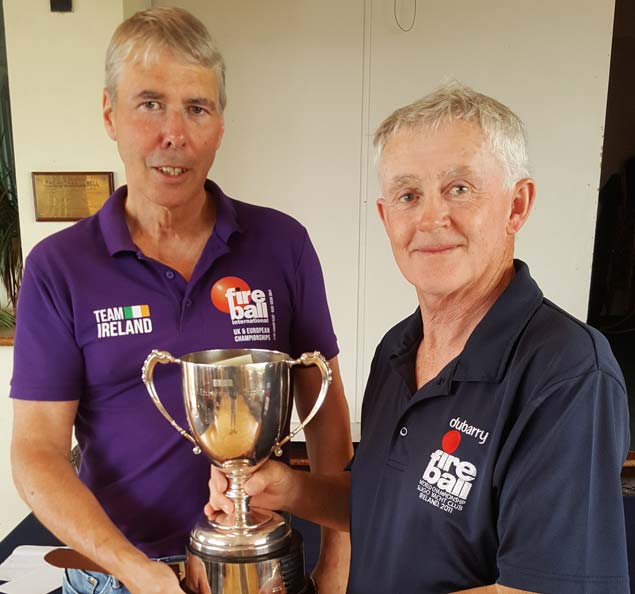 Niall McGrotty and Neil Cramer were second overall
Niall McGrotty and Neil Cramer were second overall
The light airs probably suited the duo but even so they quickly got an unfamiliar boat up to full speed and their boat handling and general racing awareness was exemplary. The pair found themselves in close quarters with regulars Louise McKenna and Hermine O'Keeffe. By the end of day two the two teams were on equal points for third place. Day two weather-wise was a bit steadier than day one but with fewer holes. It was still however a day of crews hunched down in the boat or even to leeward. Once again the race management team played a blinder and got four races in. Their thinking was undoubtedly shaped by a forecast promising almost no wind on Sunday.
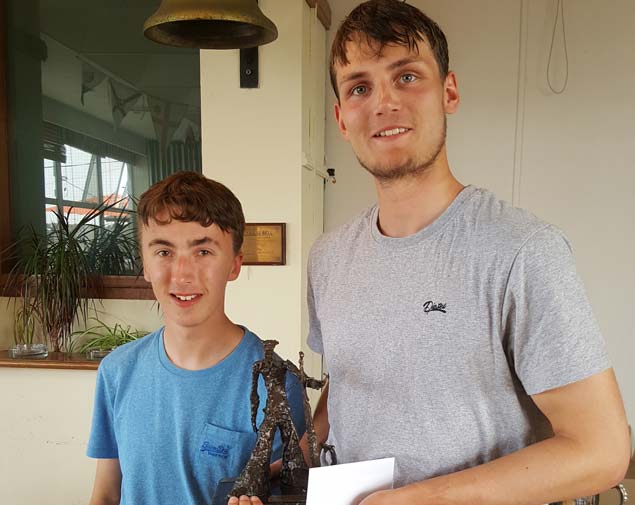 Third were Daniel Thompson and Dan Quaid
Third were Daniel Thompson and Dan Quaid
Ironically then Sunday dawned with a very solid breeze out in the bay at Skerries with a very lumpy sea built up by the easterlies.. While McCartin/Kinsella had the trophy in the bag there was a close match in play for 3rd place in particular. By the time the fleet got out and the wind steadied in direction the breeze and the sea state had settled somewhat. The start was tricky, with the pin favoured and the breeze on the line light the fleet got away in reasonable shape. The McKenna/O'Keeffe team edged ahead of the two Dans and carefully covered them around the triangular course. A strong ebbing tide, a sloppy sea with now light winds and a biggish shift to the right made the beats tricky. The all-woman team were unlucky at a mark rounding when a wayfarer got inside them and that was enough to allow the two Dans seize their moment and nip ahead, a position which they held to the finish.
In the Silver Fleet Sligo visitors, Jon Evans and Aidan Caulfield sailed consistently well and took the main prize from the Keegans, father and son team of David and Michael.
Next outing for Fireballs sees their Open Event at Greystones as part of the regatta. Then four teams head to Carnac, France for the Worlds where Irish hopes rest mainly on team McCartin/Kinsella, back in the Fireball after an absence of a year but already showing great form.
The second Fireball coaching session of the season took place in the stunning surroundings of Killaloe Sailing Club at Lough Derg on last Thursday and Friday evenings. Aimed primarily at the enthusiastic and growing silver fleet at KSC Frank Miller coached some 12 sailors in 6 boats on the optimum techniques for handling one of the most competitive yet manageable dinghies sailed on this island. The first evening was a bit of a baptism of fire for the local fleet who found winds touching 16 knots somewhat daunting. Despite a few capsizes with shouted advice and careful rescue cover the local fleet grew in confidence and eventually began to believe Miller's assertion that the boat, if properly set up, is capable of being sailed safely in 25 knots and more. The debrief ashore was indeed brief, primarily a group slagging for straying too far from the core exercise area. Further advice was absorbed over quiet pints in the local Pipers pub..
The following evening saw medium conditions fade to light which gave the fleet time and opportunity to practice hoisting, gybing and dropping their kites on a windward/leeward course. The lighter conditions allowed Miller to help the teams fine tune their sailing skills with an emphasis on boat trim and perfecting the sequence of actions needed for simple and effective spinnaker handling. Great things are sometimes achieved in baby steps and this nascent Fireball fleet may point the way forward for the next generation of Fireballers. The most recent success of Fireballs in Killaloe is down to the energy of Steffany Gorski who with Philip Despard has built upon the ongoing dedication of Jim Ryan and others. Their campaign to grow the local fleet is greatly helped by the incredible value now of Fireballs. One classic boat recently changed hands for 350 euros while good "white" Winder boats can be had for as little as 2,000 euros. One of the participating boats in the coaching sessions was the class-owned Winder composite Fireball currently on loan to Domnick O’Sullivan and Kieran Ruane, two big boat sailors who are quickly learning how much more fun Fireballs are than big boat sailing. The loan boat will be available again at the end of the summer, perhaps to a team who want to take on the DMYC frostbites next winter.
Besides teaching the obvious techniques common to all dinghies the participants learned how to quickly tune the Fireball on land and water to depower and power up the boat so that sailing it is comfortable and easy in a huge range of conditions. While the range of controls can look daunting at first one of the key differences between the Fireball and many other dinghies is how very manageable it is when set up properly. Miller demonstrated the initial set-up to get optimum pre-bend and then explained the various controls and showed how effective they are. He also emphasised how important it is to get everything working properly on the boat so that sailors can get on with enjoying their sailing. This is especially true of the older boats which might need more TLC but with care are still extremely competitive. By the time of the final debrief in the Pipers pub, the sailors were tired but happy and enthused for the season ahead. The next Fireball event is the National Championships at Skerries SC on 8th, 9th and 10th June being run in tandem with the Wayfarer class – all welcome! Other upcoming events include a one-day open event at Greystones on Sat 23rd June, the Worlds (and pre-worlds) in Carnac, France from 22nd-31st August, the “Ulsters” in Lough Derg YC on September 8th& 9th and the (postponed from last weekend) Munsters in Killaloe at a date to be confirmed.
Fireballs enjoyed champagne sailing in Dun Laoghaire on Saturday for a pre-season coaching session with Ger Owens, thanks to the support of Irish Sailing. Ger's wry and funny delivery once again reduced the most complex of questions to the key fundamentals, the ones we all know but so often forget. In the briefing he spoke especially about body symmetry and muscle memory and how those of us sailing for many years have effectively trained our muscle memory to do things in a less efficient way than we should.
The key being to break down the series of actions needed for a manoeuvre into a set of steps which are practiced slowly to get them embedded in the brain, and then speed up the routine through practice. Another incredibly simple but important tip is to keep the majority of the fleet "under your boom" to consolidate gains and avoid big losses, especially in larger fleets. After about 30 minutes of briefing the four boats took to the water with several others helping and learning from the RIB. Any fears that the beautiful weather might mean drifting conditions were thankfully banished as by now a very decent wind had become established in the harbour.
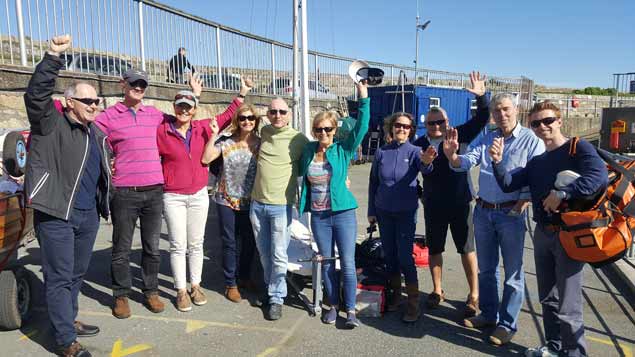 Fireball sailors at the DMYC for the training session
Fireball sailors at the DMYC for the training session
On the water sailors were put under pressure in an intense series of bear aways, hoists, reaches, runs, drops and round-ups and beats. Suffice to say that even those who sailed through the winter found they were rustier and less fit than they realised.
"Top of the class were Barry McCartin and Conor Kinsella who provided near textbook examples of how to dance around a racecourse"
Top of the class were Barry McCartin and Conor Kinsella who provided near textbook examples of how to dance around a racecourse. Other participants included regular teams Louise McKenna with Hermine O'Keeffe and Frank Miller with Ed Butler. A hybrid pairing of Stephen Campion with Michael Keegan completed the watery learners while Neil Cramer, Brian O'Hare and others had the pleasure of learning from the drier vantage point of the RIB.
A lunch break was accompanied by a debrief and some more discussion and then it was time to go back on the water. This time the action took place outside the harbour with even better wind. The exercises were similar but were led off by "follow the leader" style sequences with breaks downwind and up signalled by the unforgiving whistle. Such were the gusts and the pressure from the whistle that a couple of capsizes were witnessed. Those on the RIB remarked that they could already see a significant improvement in performance over the morning session. That was good to hear as those in the Fireballs were by now well stretched, especially the crews who were doing most of the hard work...
Ashore a final debrief took place at the DMYC and the fleet took to the bar for a well earned cuppa, cobwebs well and truly blown away and the fleet energised for the season ahead.
Speaking of which the next Fireball event is the Munsters in Killaloe on 12th & 13th May, with coaching and advice evenings on the preceding Thursday and Friday evenings.
Dublin Bay Fireballer Cormac Bradley Appointed as Rear Commodore Europe West in International Class
The new Executive Committee of the International Fireball Class includes Irish representation with Dublin Bay Sailor Cormac Bradley appointed as Rear Commodore, Europe West.
The Committee has been confirmed as follows;
Commodore: Christina Härdi-Landerer (Switzerland)
Rear Commodore Australasia: Ben Schulz (Australia)
Rear Commodore Asia: Hiroshi Kato (Japan)
Rear Commodore Africa: David Laing (South Africa)
Rear Commodore North America: Debbie Kirkby (USA)
Rear Commodore Europe East: Jakub Napravnik (Czech Republic)
Rear Commodore Europe West: Cormac Bradley (Ireland)
Afloat.ie understands Tom Egli (Canada) is staying on as Technical Officer, but other appointments, Secretary, Treasurer, Webmaster and Publicity Officer have yet to be discussed/confirmed.





























